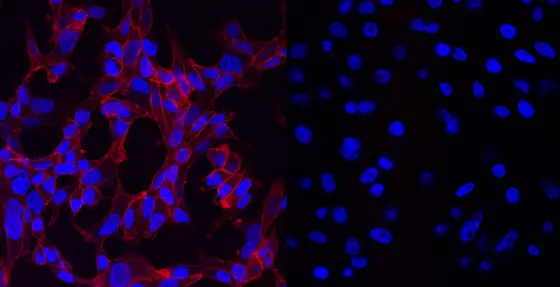The so-called bimodal radiopharmaceutical binds to prostate-specific membrane antigen (PSMA). PSMA is a surface protein that is normally present on healthy prostate cells, but is found at much higher levels on prostate cancer cells. It is barely found in the rest of the body. Therefore, PSMA is an ideal target for diagnostic purposes as well as targeted therapies against prostate cancer.
Radioactive labeling of the bimodal pharmaceutical as a PET tracer makes it possible to locate the tumor and its metastases using a combination of positron emission tomography (PET) and computerized tomography (CT) or magnetic resonance imaging (MRI), respectively. This non-invasive imaging can also be used for surgical planning.
During surgery, the fluorescent dye that is coupled to the pharmaceutical helps physicians differentiate between malignant and healthy tissue, thus facilitating very precise removal of tumor tissue. This combined approach of imaging and therapy will substantially increase the effectiveness of surgical interventions.
Ann-Christin Baranski from the German Cancer Research Center (Deutsches Krebsforschungszentrum, DKFZ) was honored with the 2017 Image of the Year Award of the Society of Nuclear Medicine and Molecular Imaging (SNMMI) at its Annual Meeting.SNMMI awards the prestigious distinction for the most promising advances in the field of nuclear medicine and nuclear imaging.
The project led by Matthias Eder, German Cancer Consortium (DKTK) Freiburg, and Klaus Kopka, DKFZ, has been supported since 2016 by the Federal Ministry of Education and Research (BMBF) as part of its VIP+ (Validation of the technological and social innovation potential of scientific research) funding program. This initiative helps scientists examine and prove the innovation potential and possible applications of their research results.
The researchers' goal is a first clinical application of the bimodal radiopharmaceutical that can be used in a combined approach for nuclear-medical imaging (PET/MRT or PET/CT) and for subsequent intra-operative fluorescence-guided navigation during robot-assisted removal of prostate cancer and its metastases.
Please find more information at:
http://www.snmmi.org/NewsPublications/NewsDetail.aspx?ItemNumber=24411
http://www.auntminnie.com/index.aspx?sec=sup&sub=mol&pag=dis&ItemID=117606



